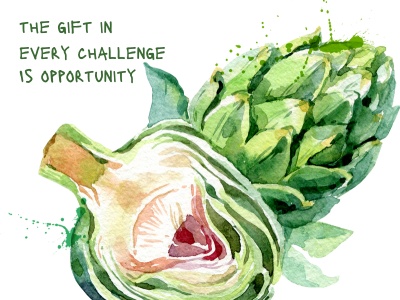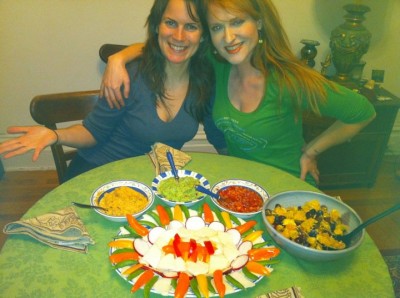Last updated on October 26th, 2023 at 05:44 pm
 As part of my dream journey to be an international life coach, facilitator, and public speaker who speaks at TED, I’ve challenged myself to eat a “raw” diet for three months. Working on my dreams seems the perfect time to shift my eating habits. Accomplishing tough challenges and changes helps prepare you for the challenges you face while working on your dreams.
As part of my dream journey to be an international life coach, facilitator, and public speaker who speaks at TED, I’ve challenged myself to eat a “raw” diet for three months. Working on my dreams seems the perfect time to shift my eating habits. Accomplishing tough challenges and changes helps prepare you for the challenges you face while working on your dreams.
Eating “raw” means eating a 100% vegan, plant-based diet and not heating any foods above 108 degrees. Basically, it means we will not be eating anything that has been cooked or processed. When I prepare raw meals, I joke that it is “uncooking.” You can still be surprisingly creative.
My dear friend Steph and I have perfected raw recipes for zucchini fettucini with pesto; “spaghetti” and “nutballs,” Thai cucumber noodles with almond sauce, raw ginger cookies, and other fun recipes.
I gained a lot of inspiration from various websites out there that feature recipes and strategies; some favorites include Raw Divas, Rawmazing, and The Raw Chef.
My raw foods-eating friend Steph jokes with me about starting a raw TV station, billing ourselves as “RawGrrls” or something fun with a theme song “Don’t Cha” by the Pussycat Dolls, which features the line, “Don’t cha wish your girlfriend was RAW like me…”
The thing is, changing your eating habits to adopt healthier practices can feel challenging. Raw means not only zero processed food, which I am happy about. It also means no cooked food. No baked goods, no bread, no pasta, no stir-fries. No eggs, black beans, lentils, or some of the other staples that I count on for protein in my vegetarian diet.
Can you imagine eating no cooked food for three months?
I won’t lie and say that it’s effortless. It can be challenging and does require some time and preparation. That’s why I make it silly and fun. It becomes an adventure. And this is how you should approach your work for your big dream.
I’ve been traveling so much lately that I have neglected to prepare for my new raw culinary adventure. I have barely finished unpacking, catching up with laundry, and opening mail, and I just hadn’t had time to think through the strategy for making raw eating work best.
So, I sat down and developed a basic plan for my transition.
Transitioning to a Raw Food Diet: 15 Tips for Success
Switching to a raw diet, often called a raw food diet, involves consuming primarily uncooked, unprocessed, and plant-based foods. This diet is based on the idea that cooking destroys food’s natural enzymes and nutrients. Here are my thoughts:
1. Research and Education
Before transitioning to a raw diet, it is essential to learn as much as possible about its principles, benefits, and potential risks. Understanding the basics helps you make informed choices and develop a balanced approach.
2. Start Gradually
Making a sudden switch to a raw diet can be challenging. It won’t be for me as I have been a strict vegetarian for years. But if you follow the basic American diet, then begin by incorporating more raw foods into your meals while still including some cooked items. This gradual approach can help your body adjust and reduce digestive discomfort.
3. Emphasizing Fresh Fruits and Vegetables
The foundation of a raw diet is fresh produce. Focus on various fruits and vegetables to get enough diverse nutrients.
4. Include Leafy Greens
Leafy greens, like kale, spinach, and lettuce, are nutrient-dense and a key component of a raw diet. They provide essential vitamins and minerals. Add these to every shopping list!
5. Befriend Soaking and Sprouting
Some raw foods, such as nuts, seeds, and legumes, can be challenging to digest in their raw form. Soaking and sprouting these foods can make them more digestible and nutritious.
6. Explore Raw Food Preparation Techniques
Raw cuisine involves creative techniques like blending, dehydrating, fermenting, and marinating. These methods can help you diversify your menu and make raw foods more appealing.
7. Invest in Quality Equipment
Consider investing in a good blender, food processor, and dehydrator. These tools will be useful for creating raw recipes and making the preparation process easier.
8. Plan Balanced Meals
To ensure you get all the essential nutrients, plan balanced meals that include a variety of fruits, vegetables, nuts, seeds, and other raw ingredients. Seek advice from a nutritionist if needed.
9. Monitor Nutrient Intake
Keep an eye on your nutrient intake, particularly for vitamin B12, vitamin D, and omega-3 fatty acids, which can be more challenging to obtain on a raw diet. You might need supplements or fortified foods to meet these needs.
10. Stay Hydrated
Raw fruits and vegetables have high water content, but it’s still essential to stay properly hydrated. Drink plenty of water and consider herbal teas and fresh juices.
11. Listen to Your Body
Pay attention to how your body responds to the diet. Some individuals thrive on a raw diet, while others may not feel as good. Adjust your diet as needed to meet your specific health and energy requirements.
12. Be Mindful of Food Safety
Food safety is crucial when dealing with raw foods. Wash fruits and vegetables thoroughly and handle them with clean hands and utensils to prevent contamination.
13. Seek Support
Connect with online communities or find support from people who follow a raw diet. They can offer advice, recipes, and motivation. See if you can get a friend to try a raw diet.
14. Be Open to Flexibility
A 100% raw diet can be challenging to maintain long-term for some people. You can choose to follow a high-raw diet while incorporating some cooked foods if it suits your lifestyle and health better.
15. Consult a Healthcare Professional
Before making any significant dietary change, it’s advisable to consult with a healthcare professional or a registered dietitian to ensure your dietary choices align with your health goals and requirements.
Embarking on a raw food diet is not just about changing what’s on your plate; it’s a transformative journey that aligns with pursuing your dreams. Just as I’ve challenged myself to adopt this diet as part of my journey toward becoming an international life coach, facilitator, and public speaker, it’s essential to remember that every significant change in your life, no matter how challenging, prepares you for the challenges you’ll face when working on your dreams.
The journey to a raw food diet may not always be effortless, but by approaching it with a sense of adventure and embracing the creativity it allows, you can make it an exciting part of your life. Remember, your big dream deserves your best effort, and taking care of your health is crucial to achieving your goals!
As I begin my own raw culinary adventure, I invite you to explore this path and discover the benefits it may bring to your life. Whether you choose to go 100% raw or opt for a high-raw diet with occasional cooked foods, remember that your health is paramount. Don’t hesitate to consult a healthcare professional or a registered dietitian if you have any concerns or questions.
With determination, knowledge, and a bit of fun, you can successfully transition to a raw food diet and, in the process, not only nourish your body but also nourish your dreams. So, here’s to your health, dreams, and the incredible journey ahead. Bon appétit!

Lisa P. Graham is an inspirational writer, life coach, TED motivational speaker, and globe-trotter whose passion is to help others to find happiness and meaning in their daily lives. A political activist at heart, Lisa would like to empower more women to run for political office as a way to create positive change in the world. You can find her on her website or watch her TEDx speech on YouTube.
Note: Articles by Lisa may contain affiliate links and may be compensated if you make a purchase after clicking on an affiliate link.




